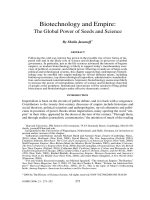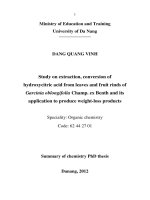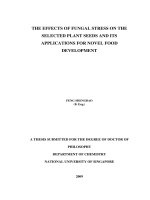Lec14 seeds and fruit
Bạn đang xem bản rút gọn của tài liệu. Xem và tải ngay bản đầy đủ của tài liệu tại đây (1.31 MB, 27 trang )
Lecture 14: Seeds and Fruit
•
•
•
•
•
•
Seeds
Fruits
Fruit types
Seed dispersal
Video: seed dispersal
Real fruit samples
What is a seed?
•
•
•
•
A matured ovule, containing:
1. a plant __________
2. a food supply
3. covered by a _____________
Embryo
• The seed contains a well-formed
multicellular young plant embryo (germ)
• Embryo is _________ (2n)
• It will become a whole plant
Nutritive tissue
• Seed contains a food supply
• Stored food contains enough energy for the
embryo to grow through the soil, when
seedling is unable to photosynthesize.
• Food source can be the _________, which is
______ (_n) – as a result of double fertilization
Seed coat
• A thick protective coat – outer layer of the seed
• Formed from the _______________
Seed coat
Gymnosperm seed
• Single fertilization produces the diploid embryo
(2n)
• Food source is the haploid megagametophyte
Flowering plant seed
•
•
•
•
•
In angiosperms (flowering plants) there is
DOUBLE _______________
Which produces a diploid ________(2n) and,
A triploid (3n) __________
Endosperm is the
food source
Dicot vs. monocot seed
• Dicot has two
cotyledons (like bean)
• Endosperm (food) is
kept in the _________
• Monocot has one
__________ which
absorbs the endosperm
tissue during
germination (corn)
Fruit
• In flowering plants – Fruit is a mature,
ripened o_____ that contains the seeds
• Pericarp – the ovary wall
Fruit types
• A. Simple
• B. Aggregate
• C. Multiple
ovary
A. Simple fruit
• A. Simple fruit – develops from a ______
ovary of a single flower.
• Simple fruits can be either fleshy or dry when
mature
• Simple fleshy fruit
• 1. __________
• 2. Hesperidium
• 3. __________
• 4. Pepo
• 5. _________
Simple fleshy fruit
• 1. Berry – entire fruit wall is soft
and fleshy at maturity. Inside is
slimy.
• For example, grapes, tomato, etc.
• 2. _______________ is a berry
with tough, leathery rind (peel)
• Examples: oranges, lemons,
other citrus.
Simple fleshy fruit: drupe
• 3. _______ type – outer part of fruit wall is
soft and fleshy, inner part is hard and stony
• For example: ______________________
Simple fleshy fruit: pepo
• 4. ________ – also a fleshy fruit with a tougher
outer rind
• All member of the squash family: pumpkin,
melons, cucumbers
Simple fleshy fruit: pome
• 5. Pomes: most of the fleshy part of pomes
develops from the enlarged base of the perianth
(corolla and calyx) that has fused with the ovary
wall
• Pomes include ___________________
Simple dry fruit: capsule
• Simple dry fruits are dry (not fleshy) at
maturity. Simple dry fruits that open at maturity
include: capsules and legumes
• Capsule – fruit is dry at maturity and splits open
along several seams
• Example: Cotton
Simple dry fruit: Legumes
• Legumes are dry at maturity and split open
along _______ seams
• Examples: pea pods, bean pods, peanut
Simple dry fruits
• Simple dry fruits that do NOT open at
maturity include
• Caryopsis: seed coat is fused
to the ovary wall (cereal grains
like ____________________)
• Nuts: single-ovary wall and
seed coat remain separate,
ovary wall is very hard
(acorns)
B. _____________
• __________ fruit develops from one flower
with many separate pistils/carpels, all ripening
simultaneously
• Examples: strawberry, raspberries, blackberries
C. Multiple fruit
• Multiple fruit develops from ovaries of
several flowers borne/fused together on the
same stalk
• For example: ____________
What is the purpose of the fruit?
• The main function of the fruit is to disperse the seeds
• Dispersal is important because
• 1. It spreads the progeny in order to colonize new
environments
• 2. Reduces ______________ for resources with parents
• 3. Reduces the chances of predators destroying all of the
plant’s yearly seed production
• Four types of seed dispersal:
• A. Self dispersal
• B. ______ dispersal
• C. Water dispersal
• D. _______ dispersal
A. Self dispersal
• Plants disperse their seeds by forceful ejection –
explosive fruits!
• Witch hazel, squirting cucumber (jet
propulsion)
Self dispersal
• The peanut plant sows
(buries) its own seeds!
• Geocarpic: carpel grows
inside the earth (soil)
B. Wind dispersal
• Fruit and seeds may have special devices for
wind dispersal
• Plumes catch wind currents: Dandelion
• Trees take advantage of their great heights for
wind dispersal. Fruits with wings are used to
slow the descent to land: maple, ash fruit
C. ___________ Dispersal
• Fruits and/or seeds use flotation devices to
travel by water (in rivers, oceans, etc.)
• Fruit may have air spaces and corky floats: for
example ________________
D. Animal dispersal
• Plants have _____________ with animals to
accomplish seed dispersal
• Many plants depend on animals for seed
dispersal; they may offer a nutritional reward
• Animals learn to recognize ripened fruit colors
• Fleshy fruits eaten and dispersed
with feces









